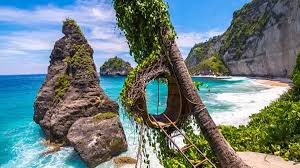
Bali, often referred to as the „Island of the Gods,“ is not only renowned for its stunning beaches and vibrant culture but also for its rich historical heritage. This heritage is epitomized in its ancient temples, majestic palaces, and sacred shrines, each narrating a story of the island’s past and its spiritual significance. Exploring these sites offers a glimpse into Bali’s unique blend of history, religion, and art.
Temples: Sacred Centers of Worship and Culture
Bali’s temples, or „pura,“ are fundamental to its cultural and spiritual landscape. Each temple has its unique charm and historical significance, often set against breathtaking natural backdrops.
Pura Besakih: The Mother Temple
Situated on the slopes of Mount Agung, Bali’s highest peak, Pura Besakih is the most important temple on the island. Known as the Mother Temple, Besakih comprises over 80 individual temples, with the central complex dedicated to the Hindu trinity of Brahma, Vishnu, and Shiva. The temple’s origins date back over a thousand years, and it has been a central site for Balinese Hindu rituals and ceremonies ever since. The architecture of Pura Besakih reflects the Balinese style with tiered pagodas, intricate stone carvings, and towering gateways.
Pura Tanah Lot: The Iconic Sea Temple
Perched on a rocky outcrop in the sea, Pura Tanah Lot is one of Bali’s most photographed temples. Its dramatic location makes it particularly stunning at sunset. The temple, believed to have been established in the 16th century by the priest Nirartha, is dedicated to the sea gods. The site is imbued with a mystical quality, enhanced by the sound of waves crashing against the rocks and the view of the temple silhouetted against the evening sky.
Pura Luhur Uluwatu: The Cliffside Marvel
Pura Luhur Uluwatu, located on the southwestern tip of the Bukit Peninsula, sits atop a steep cliff about 70 meters above the Indian Ocean. This temple is dedicated to Sang Hyang Widhi Wasa in his manifestation as Rudra. It is not only a significant spiritual site but also a great spot for viewing traditional Kecak dance performances, which are held daily with the ocean and sunset as a backdrop.
Palaces: Residences of Royalty
Bali’s palaces, or „puri,“ offer a window into the island’s regal past. These palatial complexes are often still inhabited by descendants of Balinese royalty and are used for ceremonial purposes.
Ubud Palace (Puri Saren Agung): The Cultural Heart
Located in the cultural heart of Bali, Ubud Palace was the official residence of the royal family of Ubud. Built in the 1800s, it showcases traditional Balinese architecture with its ornate carvings, lush gardens, and pavilions. The palace is not only a historical landmark but also a cultural hub, hosting traditional dance performances and art exhibitions. Its central location in Ubud makes it easily accessible, and it serves as a starting point for exploring the town’s rich artistic heritage.
Puri Agung Karangasem: The Grandeur of East Bali
Puri Agung Karangasem, located in Amlapura, the capital of the Karangasem regency, is a testament to the splendor of East Bali’s royal past. The palace was constructed in the early 19th century by the kingdom’s founder, Anak Agung Gede Jelantik. It features a blend of Balinese, Chinese, and European architectural styles, evident in its grand halls, courtyards, and water gardens. The palace complex includes the Taman Ujung Water Palace and Tirta Gangga, both known for their beautiful water features and tranquil settings.
Shrines: Sacred Spaces of Devotion
Balinese shrines, or „sanggah“ and „merajan,“ are smaller than temples but hold immense cultural and spiritual significance. These structures can be found in homes, rice fields, and other locations, dedicated to various deities and spirits.
Goa Gajah: The Elephant Cave
Goa Gajah, known as the Elephant Cave, is an ancient sanctuary near Ubud. The site dates back to the 9th century and was initially a place for meditation. The cave’s entrance is adorned with menacing carvings of demons and animals, with the figure of an elephant giving the site its name. Inside the cave, there are lingam and yoni symbols, representing Shiva, and a statue of Ganesha, the elephant-headed god. The surrounding area features a tranquil garden with fountains and bathing pools, enhancing its serene atmosphere.
Gunung Kawi: The Royal Tombs
Gunung Kawi, located in Tampaksiring, is an archaeological complex consisting of ten rock-cut shrines, or „candi,“ carved into the cliff face. These shrines are believed to be the memorials of King Anak Wungsu of the Udayana dynasty and his queens. The site dates back to the 11th century and is surrounded by lush rice terraces and a serene river valley, creating a peaceful environment for contemplation and worship.
Tirta Empul: The Sacred Water Temple
Tirta Empul, near Tampaksiring, is a sacred water temple famous for its holy spring water, where Balinese Hindus go for ritual purification. The temple complex, founded in 926 AD, is dedicated to Vishnu, the Hindu god of water. The name „Tirta Empul“ means „holy spring“ in Balinese. The central courtyard contains a series of purification baths, fountains, and pools, where pilgrims perform purification rituals to cleanse themselves spiritually and physically.
The Cultural Significance
Bali’s temples, palaces, and shrines are not merely tourist attractions; they are vital components of the island’s cultural and religious fabric. Each site is imbued with a deep sense of spirituality and history, reflecting the island’s unique blend of Hinduism and traditional Balinese beliefs.
The intricate carvings, statues, and architecture found at these sites are testimonies to the skill and artistry of Balinese craftsmen. Rituals and ceremonies held at these locations provide insight into the island’s rich cultural traditions, including dance, music, and religious practices.
Moreover, these historical sites are often set in stunning natural landscapes, from verdant rice terraces and dense jungles to dramatic sea cliffs and serene water gardens. This harmonious integration of natural beauty and man-made structures enhances their spiritual and aesthetic appeal, making a visit to these sites a truly immersive experience.
Preservation and Tourism
While tourism plays a crucial role in Bali’s economy, it also poses challenges to the preservation of these historical sites. Efforts are being made to balance the influx of visitors with the need to maintain and protect these cultural treasures.
Local and international organizations are involved in conservation projects, ensuring that the integrity of these sites is preserved for future generations. Sustainable tourism practices are encouraged, promoting respect for local customs and reducing the environmental impact of tourism.
Conclusion
Exploring Bali’s historical sites offers a journey through the island’s rich past and its vibrant present. The temples, palaces, and shrines stand as monuments to Bali’s enduring cultural and spiritual heritage. They invite visitors not only to admire their beauty but also to engage with the profound traditions that continue to shape the lives of the Balinese people. Whether you are a history enthusiast, a spiritual seeker, or simply a traveler in search of beauty, Bali’s historical sites provide an unforgettable experience that connects you to the island’s soul.





